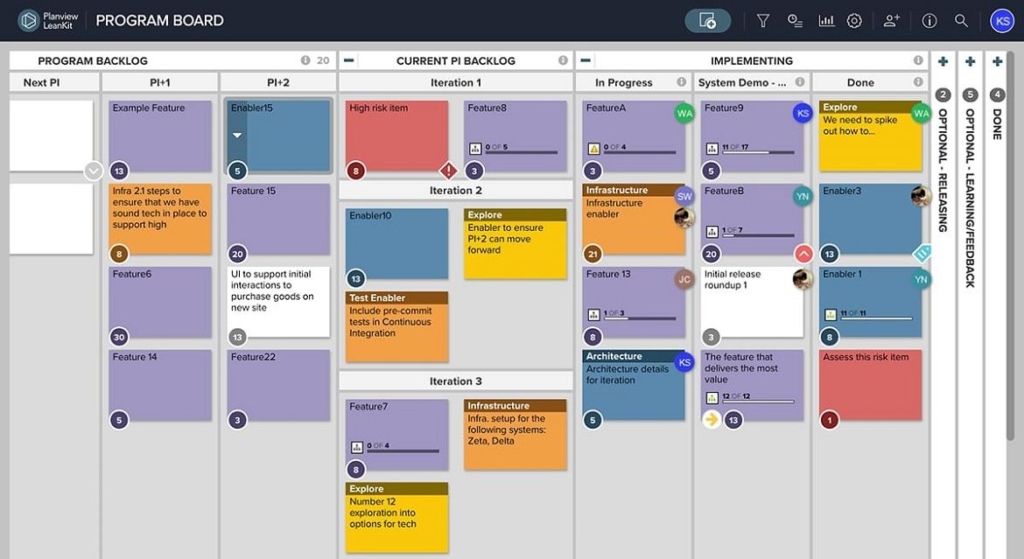Ninety-seven percent of organizations believe project management is critical to business performance and organizational success.
In today’s business world of complex products and offerings handled by teams spread across departments, states, and even continents, project management has become even more vital to the health of an organization.
Enter Kanban to save the day.
Kanban Roadmap: How to Get Started in 5 Easy Steps
You and your team can build a Kanban board in just 5 easy steps. Learn how.
Se e-boken • Kanban-färdplanAgilePlace Free Trial: AgilePlace Online Kanban Software
Sign up for a 30-day free trial and you and your team can start building online Kanban boards today. Experience for yourself how AgilePlace supports continuous delivery initiatives, eliminates waste and improves your team’s delivery processes and speed.
Börja utvärdera kostnadsfritt • AgilePlace Free Trial
What Is Kanban?
To understand Kanban and why it is one of the best project management tools on the market, it helps to first understand its history and origin.
Kanban began in the early 1940s at Toyota. It was developed by Taiichi Ohno, an industrial engineer for Toyota, in response to the need to increase productivity and efficiency. One day, Ohno noticed that supermarkets restocked their items based on their inventory, rather than vendor’s supply. It was a “just-in-time” approach that matched inventory with demand.
That observation sparked the idea to develop the Kanban method, a visual system of project management. Kanban is Japanese for “visual signal” or “card.” Toyota line workers used these highly visual cards to communicate with one another about what needed to be done and when.
The visual nature of Kanban is the key to its success.
At Toyota, Kanban helped the company keep pace with this new just-in-time approach to inventory which, in turn, helped drastically reduce cost-intensive inventory as well as increase cost-effective production.
Fast forward 60+ years, when a man named David J. Anderson, among other thought leaders like Jim Benson and Corey Ladas, applied the concept of Kanban to IT, software development and more. The application of Kanban to project management at all levels has become even more sophisticated over the past decade, leading to several robust Kanban applications for businesses.
Why Does Kanban Work?
They say a picture is worth a thousand words, and it turns out, “they” are right. The brain processes visual information faster than text. Plus, visual information comprises a whopping 90% of the data that comes into our brain. It appears, then, that our brains are hardwired for the visual.
Kanban is a project management tool that harnesses the power of visual information. It’s akin to using sticky notes on a whiteboard and moving them around based on where they are in the process.
This visualization helps you to really “see” the work and better understand its flow. It also helps team members easily communicate with one another. Lastly, it is a system that fosters continuous improvement and evolution.

4 Main Principles of Kanban
- Visualization of Work: Kanban is visual, as stated. That’s its strength. The visual cues of Kanban help team members communicate quickly and efficiently about every aspect of a project.
- Work-in-Progress Limits: While multi-tasking has its place, it turns out that it can sometimes slow down production. When there are too many tasks in progress at once, nothing seems to reach the finish line. Work in progress limits, aka WIP limits, help maintain the flow of work so that more is accomplished in less time.
- Maintaining Flow: Ideally, work should flow from “to do” to “doing” to “done” in an even and efficient manner. The constant monitoring of this flow to both prevent and fix bottleneck situations where work can get stuck is what maintains proper flow. The visual nature of Kanban helps zero in on where bottleneck issues are occurring and why.
- Continuous Improvement:Kanban carries alongside it a natural and welcome side effect – continuous improvement. The more a team utilizes Kanban to streamline their efforts, the more they continue to improve at meeting project deadlines and goals. Kanban is all about evolving to the next level of efficiency and productivity.
How to Kanban
Introducing Kanban to your existing project management style and technique is a painless and seamless process. Kanban is not a system of disruption. Rather, it takes what is already there and improves upon it incrementally and over time to create the most efficient and effective approach to any given process or project. It’s evolution, not revolution.
Visualize and map current workflow
This step is vital to success, so do not skimp. If you don’t have an accurate visual representation of your current workflow, you can’t know what to improve upon or how. So, be honest and don’t try to redesign your process at this stage of the game. You can’t really see things clearly until it’s all mapped out. Then, and only then, should you decide what you can improve upon. In the beginning, it will be a process of trial and error until your team finds its sweet spot.
Monitor the flow
Once the work is on the board, properly categorized, it’s time to move it. Ideally, the work should move evenly and efficiently from “to do” to “done.”
Unfortunately, real life never quite fully lives up to an ideal and much experimentation is needed to find a baseline of optimal workflow. And, of course, things always come up, so this step is constantly being worked on in the Kanban system.
As you monitor the board, ask yourself: “How does the work flow?” and “Where does it get stuck?” Take note of what works and what doesn’t so you can improve upon the good flow and problem-solve the bottlenecks.
A great way to begin observing the flow of work is with routine meetings on a daily and weekly basis. The daily meetings should address the immediate concerns and accomplishments. This allows your team to tweak the flow in real time and optimize productivity.
The weekly meetings should be more retrospective – a look back at the week and how the flow worked, or didn’t, and the possible reasons why. This type of meeting helps better shape the coming week ahead, ideally creating a more optimized work flow than the previous ones. That is how Kanban is set up to help a team improve and evolve incrementally over time.
Limit work-in-progress (WIP)
Monitoring the flow naturally leads into this step. Limiting work in progress is fundamental to Kanban. Setting WIP limits helps move work through to finish more efficiently and effectively. Tasks are prioritized and work in progress is limited so more reaches the finish line.
In prior models of project management, the central idea was to maximize the output and workload of every member of the team. But this kind of project management leads to bottlenecks and bad flow because too many tasks end up in the “doing” mode and never finishing. Each team member is an island scrambling to finish their tasks without any help because everyone else is also working to maximum capacity on their own tasks.
Limiting work in progress means that sometimes team members have a relatively light current workload, freeing them up to support other members to finish their priority tasks. Then, it’s their turn to receive the help of their team members when their specific tasks are deemed the priority.
This approach is radically different, but ultimately more efficient and streamlined. Plus, it helps foster a more cohesive team that feels “in it together” because they really are.
Measure and improve
Kanban is a system of continuous improvement and evolution towards greater efficiency and output. However, the only way to achieve this continuous improvement is to constantly measure how it is going and adjust accordingly. Thus, retrospective data, discussions, and breakdowns are essential to maximizing the possibilities of Kanban.
As a basic guide, try to track these four things:
- Total WIP: Total work in progress is all the tasks currently on your Kanban board – anything started but not finished. A good rule of thumb is to divide the total WIP by the number of members on your team to arrive at the average. Ask yourself: Does that seem like too much?
- Blockers: A blocked item is one that is unable to move to the next stage in the process due to an extenuating issue. It’s like a bottleneck situation in that it creates a delay, but while bottleneck is due to too much WIP, a blocker is more about the specific task and the issue holding it up. Ask yourself: “How often do blockers occur and how long do they stay blocked? Where in the process do they happen and why?”
- Throughput: Throughput is the number of items completed per time period. At the end of every established time period, often a week, record how many items moved to Done without moving back. Track this number each period to assess how changes to your Kanban system affects how much work actually gets done.
- Lead Time: Lead time is how long a card takes to travel across the board, i.e. how long a task takes to move from “doing” to “done.” On each card, record the start date and end date. Assess the average time to understand how efficient and streamlined your team is at completing tasks so you can adjust accordingly.
Today’s market is overrun with a staggering number of project and task management tools. Of them all, Kanban has proven to be one of the simplest, most efficient, and most customizable tools available.
